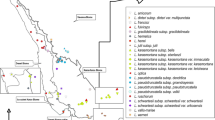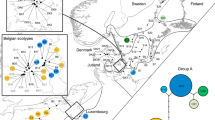Abstract
Allozyme variation in New World screwworm,Cochliomyia hominivorax (Coquerel), populations from Brazil was examined. Variability was observed in 8 of 13 enzyme loci and the frequency of the most common allele was <0.95 for seven loci. Observed and expected heterozygosities were 0.159 and 0.165, respectively. Comparisons of the Brazilian populations with previously studied populations from Costa Rica resulted in Nei's genetic distances of between 0.000 and 0.006, with the greatest distance being between populations within Brazil. Comparisons with Mexican populations using only three loci resulted in genetic distances ≤0.031. Goodness-of-fit statistics for Hardy-Weinberg equilibrium and Wright'sF statistics indicated small deviations from expected equilibrium genotype frequencies and low levels of differentiation between populations within Brazil. Differentiation among screwworm populations from Brazil, Costa Rica, and Mexico was minimal.
Similar content being viewed by others
References
Ayala, F. J., Tracey, M. L., Hedgecock, D., and Richmond, R. C. (1974). Genetic differentiation during the speciation process inDrosophila.Evolution 28576.
Dear, J. P. (1985). A revision of the New World Chrysomyini (Diptera: Calliphoridae).Rev. Bras. Zool. 3109.
Dev, V., LaChance, L. E., and Whitten, C. J. (1986). Polytene chromosomes, karyotype correlations, and population cytology of the primary screwworm fly.J. Hered. 77427.
Graham, O. H. (1985). Symposium on eradication of the screwworm from the United States and Mexico.Misc. Publ. Entomol. Soc. Am. 621.
Guimaraes, J. H., Papavera, N., and do Prado, A. P. (1983). As miiases na regiao neotropical (identificacao, biologia, bibliografia).Rev. Bras. Zool. 1239.
Knipling, E. F. (1955). Possibilities of insect control or eradication through the use of sexually sterile males.J. Econ. Entomol. 48459.
Krafsur, E. S., and Whitten, C. J. (1993). Breeding structure of screwworm fly populations (Diptera: Calliphoridae) in Colima, Mexico.J. Med. Entomol. 30477.
Krafsur, E. S., Whitten, C. J., and Novy, J. E. (1987). Screwworm eradication in North and Central America.Parasitol. Today 3131.
LaChance, L. E., Bartlett, A. C., Bram, R. A., Gagne, R. J., Graham, O. H., McInnis, D. O., Whitten, C. J., and Seawright, J. A. (1982). Mating types in screwworm populations?Science 2181142.
McInnis, D. O. (1983). Chromosomal variation in the screwworm: polymorphism or cryptic species.Am. Nat. 122840.
McInnis, D. O., Whitten, C. J., Mackley, J. W., Peterson, R. D., II, and Spencer, J. P. (1983). Cytogenetic studies of the screwworm,Cochliomyia hominivorax (Diptera: Calliphoridae) from Chiapas, Mexico.Ann. Entomol. Soc. Am. 76628.
Murphy, R. W., Sites, J. W., Jr., Buth, D. G., and Haufler, C. H. (1990). Proteins I: Isozyme electrophoresis. In Hillis, D. M., and Moritz, C. (eds.), Molecular Systematics, Sinauer, Sunderland, MA, pp. 45–126.
Nei, M. (1978). Estimation of average heterozygosity and genetic distance from a small number of individuals.Genetics 89583.
Nomenclature Committee International Union of Biochemistry (1984).Enzyme Nomenclature Academic, New York.
Richardson, R. H., Ellison, J. R., and Averhoff, W. W. (1982). Autocidal control of screwworms in North America.Science 215361.
Stehli, F. G., and Webb, S. D. (1985).The Great American Biotic Interchange Plenum, New York.
Swofford, D. L., and Selander, R. B. (1981). BIOSYS-1: A FORTRAN program for the comprehensive analysis of electrophoretic data in population genetics and systematics, release 1.7.J. Hered. 72281.
Taylor, D. B., and Peterson, R. D., II (1994). Population genetics and gene variation in primary and secondary screwworm (Diptera: Calliphoridae).Ann. Entomol. Soc. Am. 87626.
Taylor, D. B., and Peterson, R. D., II (1995). Population genetics and gene variation in secondary screwworm (Diptera: Calliphoridae).Ann. Entomol. Soc. Am. 88690.
Vargas-Teran, M. (1991). The New World screwworm in Mexico and Central America.World Anim. Rev. Spec. Issue Oct: 28.
Wright, S. (1978).Evolution and the Genetics of Populations, Vol. 4. Variability Within and Among Natural Populations, University of Chicago Press, Chicago.
Author information
Authors and Affiliations
Rights and permissions
About this article
Cite this article
Taylor, D.B., Peterson, R.D. & Moya-Borja, G.E. Population genetics and gene variation in screwworms (Diptera: Calliphoridae) from Brazil. Biochem Genet 34, 67–76 (1996). https://doi.org/10.1007/PL00020597
Received:
Revised:
Issue Date:
DOI: https://doi.org/10.1007/PL00020597




